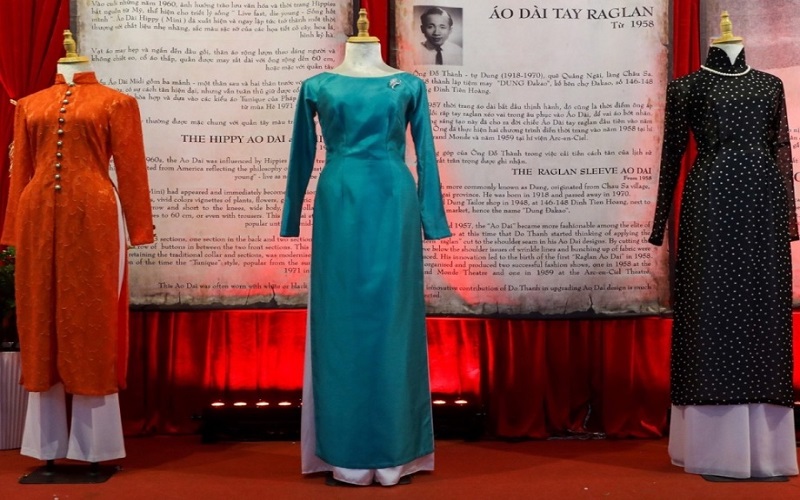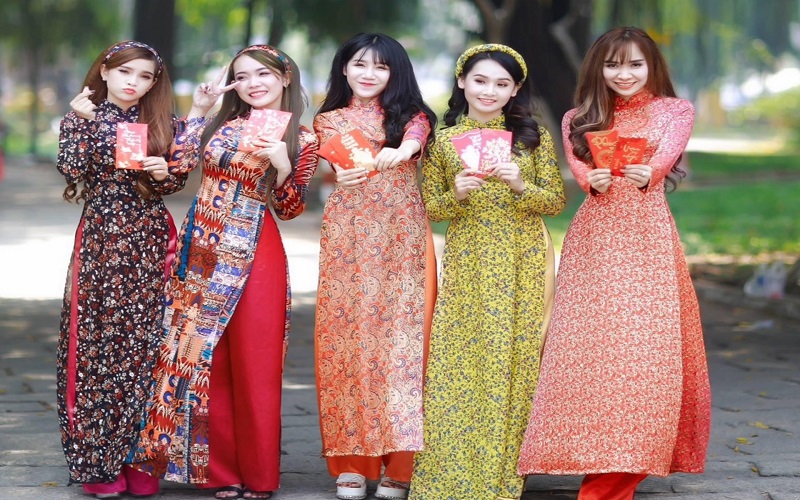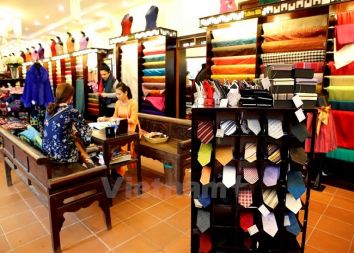Áo Dài Vietnam: Long Dress 's History and Color Meanings
Áo Dài, (Vietnamese Traditional Long Dress - Pronunciation "Ao Zai") is one of the country’s most striking symbols of beauty. Over hundreds of years, the Áo Dài has evolved alongside Vietnam, going from regal to practical, humble to high fashion, and back again. The Vietnamese Áo Dài is appreciated by the young and old alike, and its elegant lines flatter both men and women. If you’re interested to learn more about the story of Áo Dài and tips for making your own Vietnamese Áo Dài.
1. Diagram & Parts of Vietnamese Ao Dai:
The classic collar of Ao Dai Pattern is about 4 to 5 cm high. Today, the style of the long collar is varied, such as the heart neck, round neck, U-neck, and pearls on the collar.

The bodice is measured from the neck to the waist. Buttons of Ao Dai are usually from the neck to the shoulders and then down to the hip. From the waist, the body of the Ao Dai is split into two flaps, the split position is on both sides.
Ao Dai has two flaps: front and back. In the past, the front flap was equal to the back one, but today there are many types of front skirts that are shorter than the back ones. On the front hem of the shirt is often embroidered with patterns or poems. Sleeves are measured from the shoulder, sewn close to the arm, have a loose or long sleeve style that goes past the wrist.
Ao Dai is worn with pants instead of the old dress. Long clothes are sewn to the heels, wide pants. Long clothes that used to be made of sturdy fabric are now often sewn with soft, loose fabrics. The most common color is white. But the current fashion trend is that the long dress has a color that matches the color of the shirt. But today, it is also innovated with a long skirt to create a gentle and elegant look.

The weakness of modern Ao Dai is that it does not use traditional patterns, modern sewing methods do not use the philosophy of the five elements, cannot be combined with accessories used in the past such as the five-body shirt, so it is not used for communication. save culture. In daily life, modern Ao Dai is quite inconvenient because it is tight.
2. History and Evolution Story of Ao Dai:
The story of origin of Áo Dài is believed to be started in 1744, when Vietnam was divided into two regions, the Southern Region (Đàng Trong – Controlled by Nguyen ‘s Lords) and Northern Region (Đàng Ngoài – Controlled by Trinh ‘s Lords). To distinguish their people, Lord Nguyễn Phúc Khoát of Southern Region asked his subjects to wear a front-buttoned gown with trousers. This five-panel dress (áo ngũ thân) was the inspiration for the modern Áo Dài. Royals and elites made their dresses from the finest silk, with intricate details and vibrant colours to represent rankings in court.

In the 1930s, the dress was simplified into two parts by Vietnamese artist Le Mur Nguyễn Cát Tường. The front flap was extended to reach the ankle, and the form became more fitted. As with many ‘westernized’ ideas, the style was only reluctantly received at first. However, after Le Mur designed an Áo Dài collection for Queen Nam Phương, wife of Vietnam's last Emperor Bảo Đại, urban women started to embrace and popularize the more contemporary style.
After the establishment of the Democratic Republic of Vietnam, Hồ Chí Minh penned an essay in 1947 noting that the Áo Dài was not fit for the fields or the factory, asking Vietnamese to adapt their attire to be more efficient for work. As a result, the Áo Dài became a dress saved for professional appearances and special occasions.

Nowadays, across the country, female highschool students are required to wear the dress for at least one day a week. Girls in white Áo Dài riding their bicycles to school have inspired many Vietnamese songs, poems, and paintings. The Áo Dài is also worn by ladies of all ages whenever it’s time to make a good impression. You can visit Ao Dai Museum in Ho Chi Minh City or Vietnamese Women Museum in Hanoi to understand more about importance of Vietnamese Ao Dai in the life of locals.
3. Modern Styles of Vietnamese Áo Dài:
Boat neck, cropped length, short sleeves--modern designers are not afraid to explore creative routes when it comes to Vietnamese Áo Dài. Some of these new takes on the traditional dress have made it more practical, which means they can be worn in less formal settings. Knee-length styles are convenient for wearing on motorcycles and bicycles, and you’ll see a variety of more casual collars worn on summer days, including scoop neck and boat neck styles.
4. When to wear Traditonal Áo Dài in Vietnam:
Vietnamese women and men love wearing Traditional Áo Dài with Nón Lá (Conical Hat) for photo shoots in beautiful settings. Golden Autumn days in Hanoi call for photo sessions around Hoàn Kiếm Lake. During Tết Holidays (Lunar New Year) you’ll see the dress in all its glory as women wear it to visit friends and family, and pay tribute at temples and shrines. A wedding is the perfect time to wear one’s best Áo Dài. In Vietnam, the bride and groom and the wedding entourage will wear elaborate Áo Dài at the traditional ceremony, then guests will show up for the reception in simpler but equally colourful designs.
5. Colours Meaning of Vietnamese Áo Dài:
When choosing an Áo Dài, each colour has meaning. In Imperial times, gold was a royal colour and reserved for kings and queens. Red Color Áo Dài are usually worn during Tết Holidays for luck and prosperity. Brides and grooms may also wear red for happiness on their wedding day, so it's a good idea to come in a different colour if you're a guest. White color symbolizes purity and innocence, as seen in the white dresses of highschool students, and black is most often worn at funerals. Vietnamese women and men also choose Áo Dài colours based on their element (metal, wood, water, fire, or earth) taken from their year of birth.
6. Where to Make Your Own Áo Dài Vietnam?
Anyone can wear Áo Dài as the way to show respect. Fancy dinning, important meetings, events and celebrations are all suitable occasions, just be sure to always wear your Vietnamese Áo Dài over pants or trousers. If you are looking for ready-to-wear Áo Dài, you will be spoilt for choice at shops in Hanoi’s Old Quarter, Hue City and Hội An Ancient Town. You can also search to buy on Amazon 's Online Shops.
Hội An’s Tailors can also be the best places to make an entirely new long dress in a matter of days. Feel free to choose your own style. materials and colours to add a personal touch. To create a personalised Áo Dài, visit Hoi An Tailor Shops or Vạn Phúc Silk Village, just about 20 minutes from Hanoi 's Center. Here you can shop for high-quality worm 's silk from the source, learn about silk-making, get your Áo Dài tailored and take gorgeous photos among flowing silk ribbons. Ao Dai is also one of the Best Souvenirs to Buy in Vietnam.
See Also:

Best of Vietnam

Best Vietnamese Food You Have to Try in Vietnam
Best Food in Vietnam: Vietnamese Traditional Food is top World well known to be both healthy and...

10 Best National Parks in Vietnam
Vietnam Travel Guide: If you look for the Best Wildlife Discovery Experience in Vietnam, here are...
Read More
Best Souvenir to Buy in Vietnam
If you look for Best Things to Buy when traveling to Vietnam to bring home for your family & friends...
Read More
The 10 Best Places to Visit in Vietnam
Vietnam Travel Guide: Home to an extensive collection of historical and cultural attractions,...
Read More
Top 10 Museums You Should Not Miss in Vietnam
Vietnam, 4.000 years old country has a unique and lengthy history, culture with 54 ethnic groups. It...
Read MoreFind your trip
Vietnam Best Tours
Vietnam Car Rental
Vietnam Travel Blog
- Vietnamese People: Origin, History, Culture and Traditions
- Vietnam Currency: Best ATM and Places to Exchange Money
- Vietnam Map: Regions, Cities & Provinces Map of Vietnam
- What is illegal Things in Vietnam: Rules & Laws for Tourists
- Best Time to Travel to Vietnam to Avoid the Bad Weather
- Vietnam News: Population & Religions of 54 Ethnic Groups









